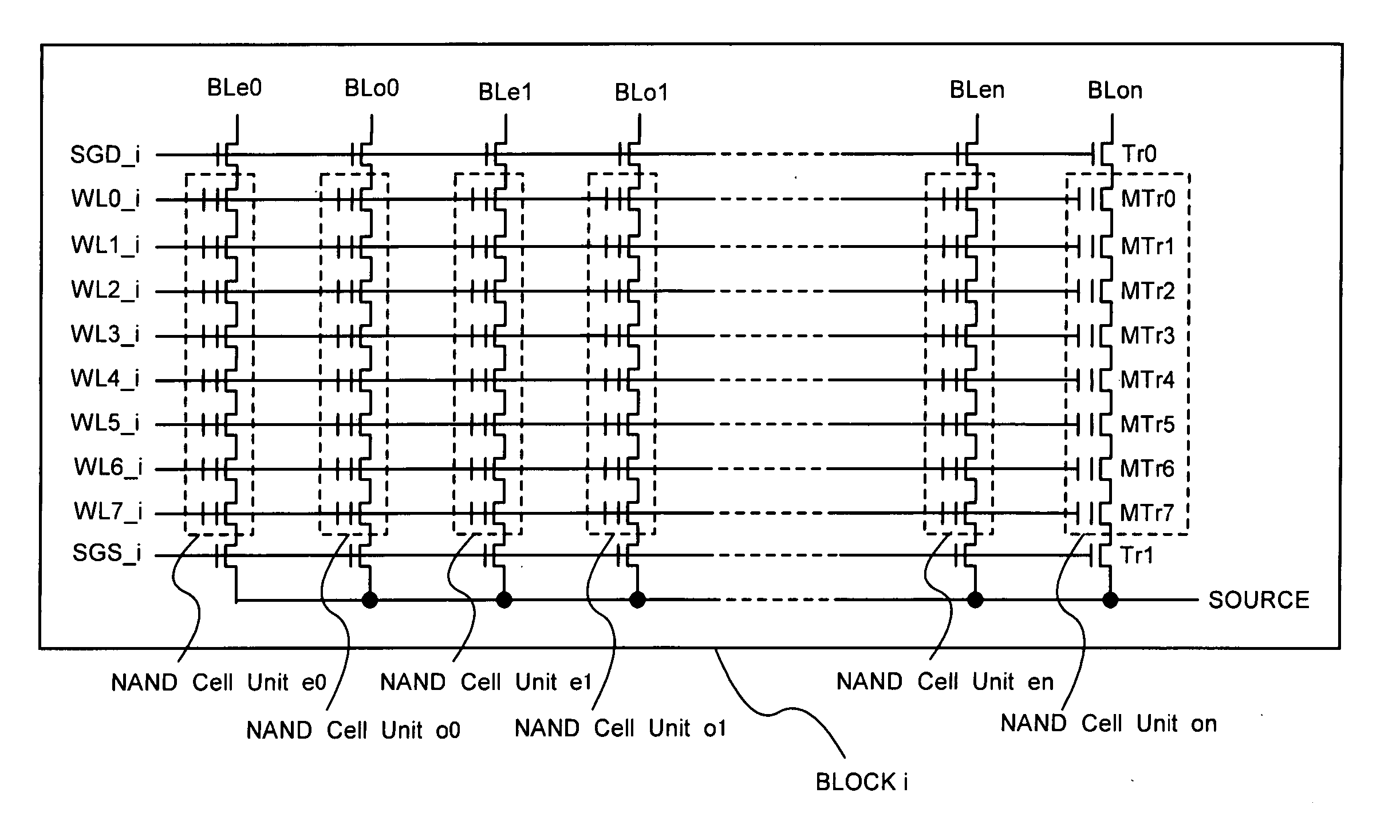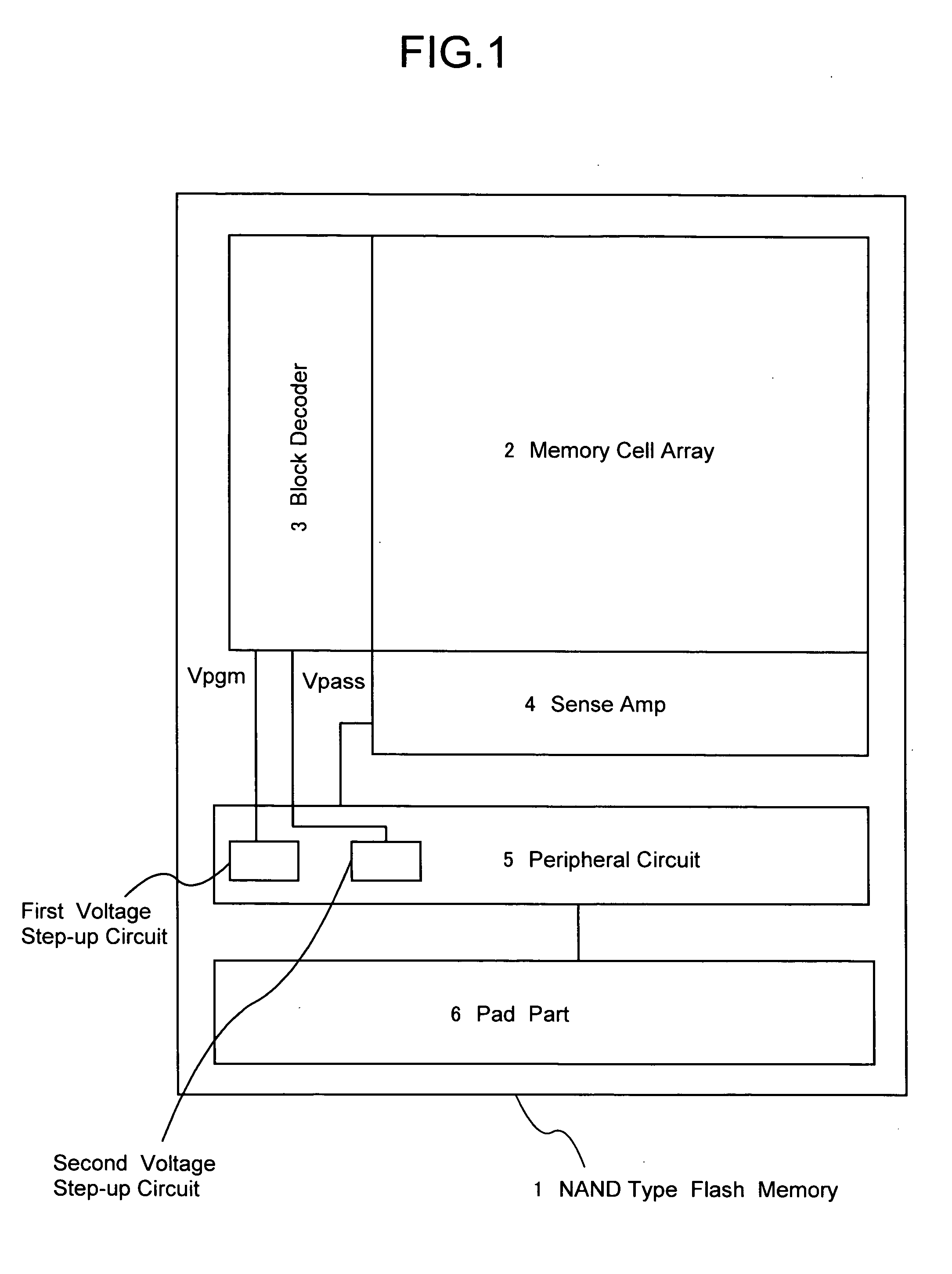Nonvolatile semiconductor memory device and a method for programming nand type flash memory
a nonvolatile semiconductor and memory device technology, applied in static storage, digital storage, instruments, etc., can solve the problems of gidl not being thoroughly prevented, program errors easily occurring, and channel potential being overly raised, so as to suppress gidl, suppress program errors, and high reliability
- Summary
- Abstract
- Description
- Claims
- Application Information
AI Technical Summary
Benefits of technology
Problems solved by technology
Method used
Image
Examples
first embodiment
[0038]FIG. 1 shows a schematic block diagram of a NAND type flash memory according to one embodiment for a nonvolatile semiconductor memory device of the present invention. NAND type flash memory 1 shown in FIG. 1 comprises a memory cell array 2 in which a plurality of electrically programmable memory cells are arranged in matrix, a block decoder 3, a sense amplifier 4, a peripheral circuit 5, and a pad part.
[0039]FIG. 2 shows a configuration of the memory cell array 2. As shown in FIG. 2, the memory cell array 2 is divided into total m blocks (BLOCK 0, BLOCK 1, . . . , BLOCKi, . . . , BLOCK m). “Block” is a minimum unit for a data erasure.
[0040] Each of the blocks BLOCK 0 to BLOCK m is configured with 2n NAND cell units e 0 to en, as FIG. 3 shows representative BLOCKi. In this embodiment, each of the NAND cell units is configured with series-connected 8 memory cells MTr0 to MTr7. The one end is connected to the bit line (BLe0, BL o0, ..., BL en to BL on) via selection gate transi...
second embodiment
[0055] In the present embodiment, another driving method of the NAND type flash memory according to the embodiment of the nonvolatile semiconductor memory devices in the present invention will be explained.
[0056] In this embodiment, the configuration is not explained because the configuration is the same as the NAND type flash memory 1 of the above-mentioned embodiment, except for a driving method during programming.
[0057] Referring to FIG. 5, a data programming operation of a NAND type flash memory 1 of the present invention will be explained. The program operation of the embodiment is the SB method. In FIG. 5, as explained in the above-mentioned embodiment, changes for set potentials of each of the word lines WL0 to WL7 are shown, in the case where the memory cells are connected to word line WL2 in the selected NAND cell unit in which, for example, even number pages of the BLOCKi is selected for programming (for example, NAND cell unit e0 of the BLOCKi), in the data programming ...
third embodiment
[0072] In the present embodiment, another driving method of the NAND type flash memory according to the embodiment of the nonvolatile semiconductor memory devices in the present invention will be explained.
[0073] In this embodiment, the configuration is not explained because the configuration is the same as the NAND type flash memory 1 of the above-mentioned embodiment, except for a driving method during programming.
[0074] Referring to FIG. 6, a data programming operation of a NAND type flash memory 1 of the present invention will be explained. The program operation of this embodiment is ONE variation of SB 2 method. In FIG. 6, as well as the above-mentioned embodiment, changes for set potentials of each of the word lines WL0 to WL7 are shown, in the case where the memory cells connected to word line WL2 in the selected NAND cell unit in which, for example, even number pages of the BLOCKi is selected for a data programming (for example, NAND cell unit e0 of the BLOCKi), in the dat...
PUM
 Login to View More
Login to View More Abstract
Description
Claims
Application Information
 Login to View More
Login to View More - R&D
- Intellectual Property
- Life Sciences
- Materials
- Tech Scout
- Unparalleled Data Quality
- Higher Quality Content
- 60% Fewer Hallucinations
Browse by: Latest US Patents, China's latest patents, Technical Efficacy Thesaurus, Application Domain, Technology Topic, Popular Technical Reports.
© 2025 PatSnap. All rights reserved.Legal|Privacy policy|Modern Slavery Act Transparency Statement|Sitemap|About US| Contact US: help@patsnap.com



